CONSTANTINOPOLIS imitations (AD 330 - 340)
This page has ancient imitations of the CONSTANTINOPOLIS type struck under Constantine, and mules with other types.
This site has six pages of imitations.
1) An overview which includes more-detailed look at GLORIA EXERCITVS
2) VRBS ROMA , 3) This page on CONSTANTINOPOLIS, 4) the "Two-Victories" type found in the Balkans and north,
5) Other types before 340, and 6) Types from 340-347.
Image sizes are all proportional. The 18 mm official coin here sets the scale.
 Here is an official coin, the prototype for many ancient imitations.
Here is an official coin, the prototype for many ancient imitations.
CONSTANTINOPOLIS
18 mm. 2.27 grams.
RIC Siscia 224 "330-3"
Imitations of this type are extremely common in Britain. However, very few imitations are close to full size. Many are very small. I have seen recognizable and examples down to 7 mm. Next are two imitations that are unusual for their relatively large size. They are the best two among only three imitations found among a hoard of about 1000 pieces I had the chance to look through in 1998.
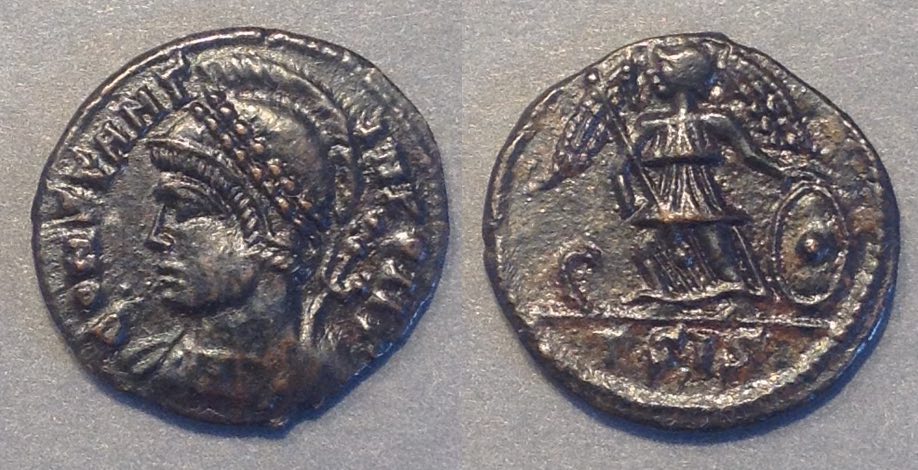 17-16 mm. 6:00. 1.87 grams.
17-16 mm. 6:00. 1.87 grams.
An imitation in excellent style and virtually full size.
CONSTANT-INPOLIS [sic, letter "O" missing]
/ΓSIS in exergue. [RIC lists only B and D]
RIC Siscia 224 variety.
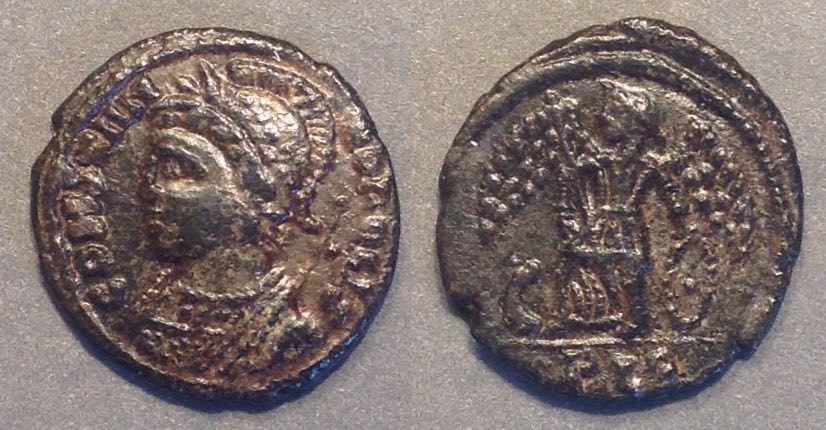 15 mm. 1.79 grams.
15 mm. 1.79 grams.
A slightly smaller imitation in good style.
CONSTAN-NOPOLIS [sic, letters "TI" missing]
Victory with wings of dots
in Exergue: PLG [mark of Lugdunum]
Prototype: RIC Lyon 246 of AD 330-1.
The main page on imitations of 330-340 noted that Lugdunum apparently minted some official coins of smaller module than other mints. The next piece is of excellent style and correct legends, but is only AE14, which strains the limits of the size of official pieces. I hesitate to decide if this is an imitation:
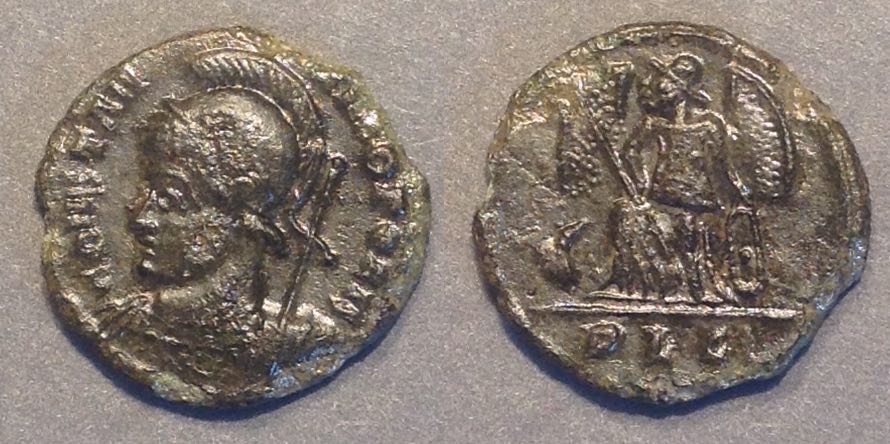 14 mm. 1.15 grams.
14 mm. 1.15 grams.
Good style and full legend. Is this official and just very small?
In exergue: PLG
Prototype: RIC Lyons 273 of AD 335.
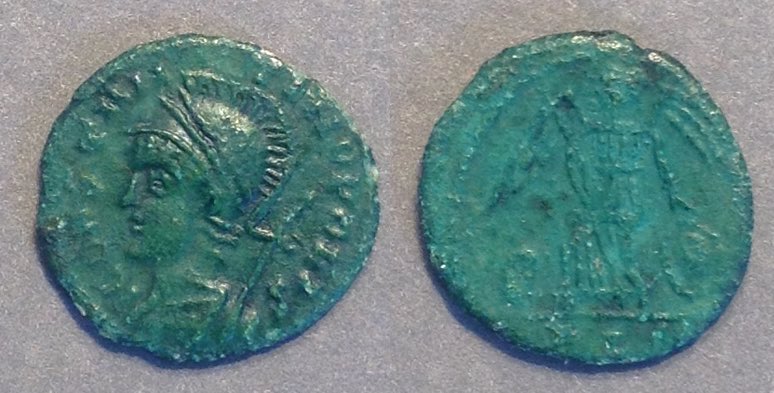
14 mm. 0.90 grams. Bright green.
Good style and correct legends.
PLG in exergue.
It is only the small size that suggests it might be an imitation.
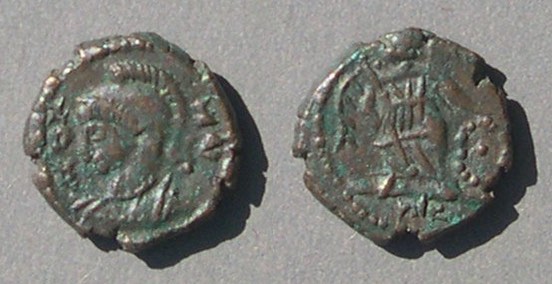 12 mm. Thick. 1.50 grams.
12 mm. Thick. 1.50 grams.
Very crude letter-like shapes form a short obverse legend and reverse exergue.
Next are four small imitations from the English midlands with the distinctive English dark green patina.
All are 14-13 mm.

Next are seven lousy English imitations. But, if you think these are bad, I assure you that there are many thousands found in even worse shape. They range for 14 to 11 mm. Click the image to double its size.

Mules. Those who made unofficial imitations did not seem to care much about making sure obverses and reverses were combined properly as on official coins. There are "CONSTANTINOPOLIS" obverses with wolf-and-twins reverses that belong on the VRBS ROMA type. When a coin has an obverse and reverse that do not belong together it is called a mule or hybrid. Here are a few.
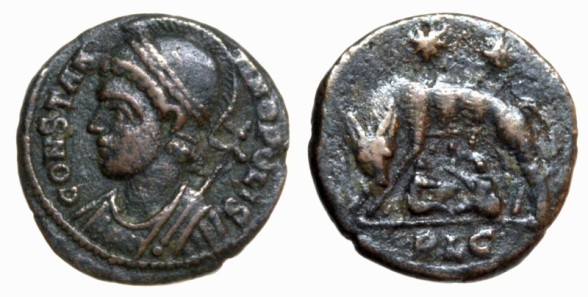 14 mm. 1.70 grams.
14 mm. 1.70 grams.
This is a mule. Here the CONSTANTINOPOLIS obverse is combined with the wolf-and-twins reverse proper to the VRBS ROMA obverse.
Good style and lettering.
This coin was published in SAN XI.2 (1980) page 37 as potentially official. Subsequently Pierre Bastien saw it and assured me this is not the official style of Lugdunum, in spite of the PLG mintmark of Lugdunum (see RIC page 140). He told me he thought it was a cast imitation. Then this piece was cited in A Survey of Numismatic Research, 1978-1984, page 288. The existence of offical mules of this period was the subject of several articles in SAN (VI,1 (1974), pages 8 and 15; VI.3 (1975) page 42; X.2 (1979) pages 20-21; X.4 (9179) page 60). After 30 years studying the matter, I think no mules of these types were intentionally issued, but I do not rule out a simple mint error in some cases.
Bought from Malter in Los Angeles, 1980.
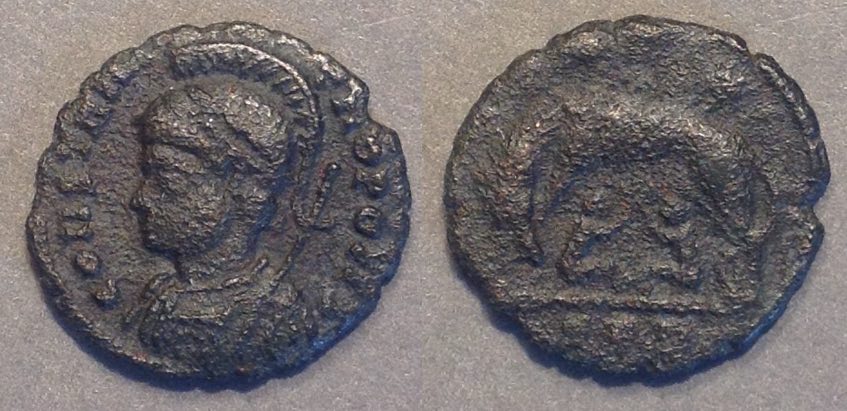 16-15 mm. 1.70 grams.
16-15 mm. 1.70 grams.
CONSTANTINOPOLIS/wolf and twins
PLC
Well-engraved with the legend well-done. Only the corrosion and wear make this coin look bad.
Most CONSTANTINOPOLIS and VRBS ROMA coins from mints other than Lugdunum are larger, but I have seen enough well-produced 15 mm coins with a Lugdunum mintmark to make me wonder if they could be official mint products. Or, did some counterfeiters in Britain engrave beautiful dies to strike coins on small flans? With the huge numbers of tiny and obviously unofficial coins in circulation, what was the point of working so hard on making excellent dies? I learn toward thinking some of the smaller coins of Lugdunum are official.
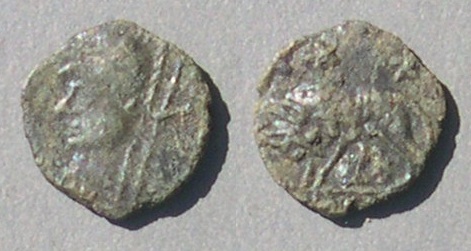 11 mm. 0. 62 grams.
11 mm. 0. 62 grams.
The busts of Roma and Constantinople are similar, but the sceptre over the shoulder characterizes Constantinople. It serves to distinguish the types when the legend is unclear.
So, this coin that looks a lot like an VRBS ROMA coin is really a CONSTANTINOPOLIS/wolf-and-twins hybrid.
Tiny and well-centered.
Comment. I wonder if the existence of so much "small change" proves that Britain had a very active monetary economy in a way that earlier times did not. If a wretched coin like this one was worth making and worth something that could be bought, transactions of small amounts were enabled. Gold coins and denarii are too valuable to spend on a single item at an ancient fast-food resturant. Gold and silver coins, however abundant, don't prove that transactions were happening frequently. It is common and worn smaller denominations that can do that.
You have just finished the page on CONSTANTINOPOLIS imitations.
Return to the introductory page on GLORIA EXERCITVS imitations and official types of 330-340.
Go to the page on VRBS ROMA imitations.
Skip to the page on imitations from AD 340-348.
 Here is an official coin, the prototype for many ancient imitations.
Here is an official coin, the prototype for many ancient imitations. 17-16 mm. 6:00. 1.87 grams.
17-16 mm. 6:00. 1.87 grams. 15 mm. 1.79 grams.
15 mm. 1.79 grams. 14 mm. 1.15 grams.
14 mm. 1.15 grams.
 12 mm. Thick. 1.50 grams.
12 mm. Thick. 1.50 grams.

 14 mm. 1.70 grams.
14 mm. 1.70 grams. 16-15 mm. 1.70 grams.
16-15 mm. 1.70 grams. 11 mm. 0. 62 grams.
11 mm. 0. 62 grams.